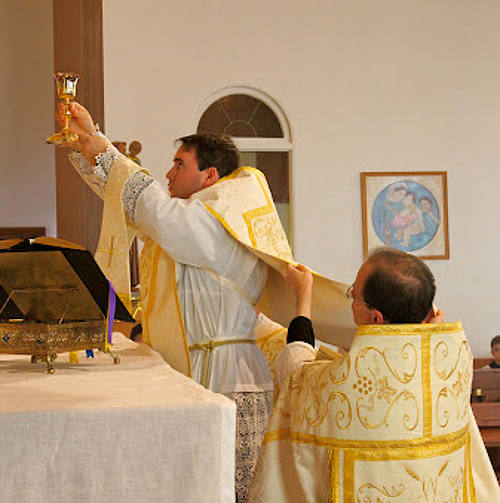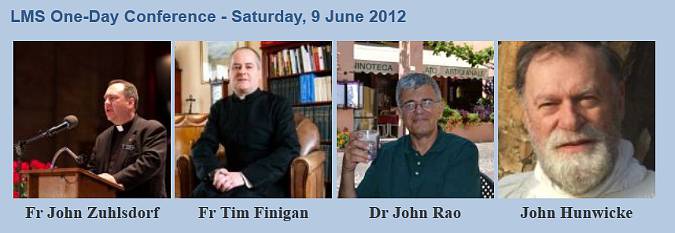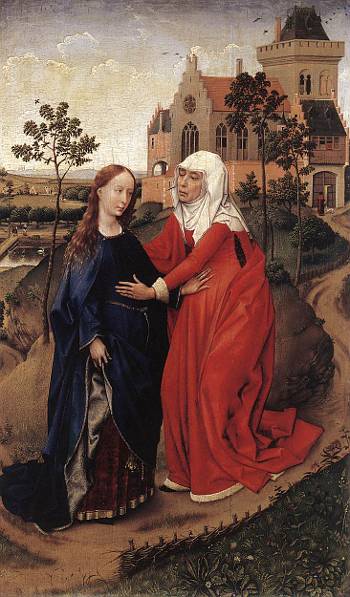I de tradisjonelle tidebønnene kommenterer lesningene nå i pinseoktaven hver dag messens evangelium. Slik er fredagens lesninger:
Lukas 5:17-26
En dag han holdt på med å lære folket, var det noen fariseere og lovlærere til stede; de var kommet fra alle landsbyene i Galilea, fra Judea og Jerusalem. Jesus hadde Herrens kraft så han kunne helbrede. Da kom det noen menn med en lam mann på en båre. De forsøkte å bære ham inn og legge ham ned foran Jesus. Men da det var uråd å få ham inn på grunn av trengselen, gikk de opp på taket, tok til side noen takstein og firte ham ned på båren, midt foran Jesus. Da Jesus så deres tro, sa han: «Venn, dine synder er deg tilgitt.» Men de skriftlærde og fariseerne tenkte straks: «Hva er dette for en, som spotter Gud? Hvem andre enn Gud kan tilgi synder?» Jesus visste hva de tenkte, og sa til dem: «Hva er det dere tenker? Hva er lettest å si, enten: Dine synder er deg tilgitt, eller: Stå opp og gå? Men for at dere skal vite at Menneskesønnen har makt på jorden til å tilgi synder» – og nå vendte han seg til den lamme – «så sier jeg deg: Stå opp, ta båren og gå hjem!» Og straks reiste mannen seg for øynene på dem, tok båren han hadde ligget på, og gikk hjem med lov og takk til Gud. De ble alle helt ute av seg av undring og priste Gud. De var grepet av frykt og sa: «I dag har vi sett det utrolige!»
Homily by St Ambrose, Bishop of Milan. – Bk. v. on Luke v.
«And, behold, men brought in a bed a man which was taken with a palsy.» The healing of this paralytic was not idle, nor its fruits limited to himself. The Lord healed him, or ever he could ask, not because of the entreaties of others, but for example’s sake. He gave a pattern to be followed, and sought not the intercession of prayer. In the presence of the Pharisees and doctors of the law, which were come out of every town of Galilee, and Judaea, and Jerusalem, many sick folk were healed, but among them is specially described the healing of this paralytic. First of all, as we have before said, every sick man ought to engage his friends to offer up prayers for his recovery, that so the tottering framework of this our life, and the distorted feet of our works, may be righted by the healing power of the word from heaven.
Here ought therefore to be advisers, who should rouse up the minds of the sick to higher things, since when the body becometh languid with sickness, the mind is apt to follow its example. With the help of such friends he can be brought and laid on the ground before the Feet of Jesus, and seem worthy of a glance from the Lord for the Lord looketh upon such as lie lowly before Him, «for He hath regarded the lowliness of His handmaiden » Luke ii. 48. » And when He saw their faith, He said unto him Man, thy sins are forgiven thee.» Great is the Lord, Who, for the sake of some, forgiveth the sins of others Who trieth some, and pardoneth the wanderings of others. Why should thine equal, O man, avail not with thee, if a slave have won power to intercede, and right to obtain, with God.
O Thou that judgest, learn to forgive thou that art sick, to pray. If thou doubt of the pardon of thy sins, because of their grievousness, get thee to the Church, that she may pray for thee, and that the Lord, accepting her countenance, may grant to her petitions what He refuses to thine. And although we are bound to accept this history as one of fact, and to believe that the body of the paralytic was healed yet remember thou also his inward cure, unto whom his sins were forgiven. The Jews said: «Who can forgive sins but God alone » And in these words they confessed the Godhead of Him Who forgave the sins of the paralytic, and themselves condemned their own unbelief in Him Whose work they acknowledged, but Whose Person they denied.



